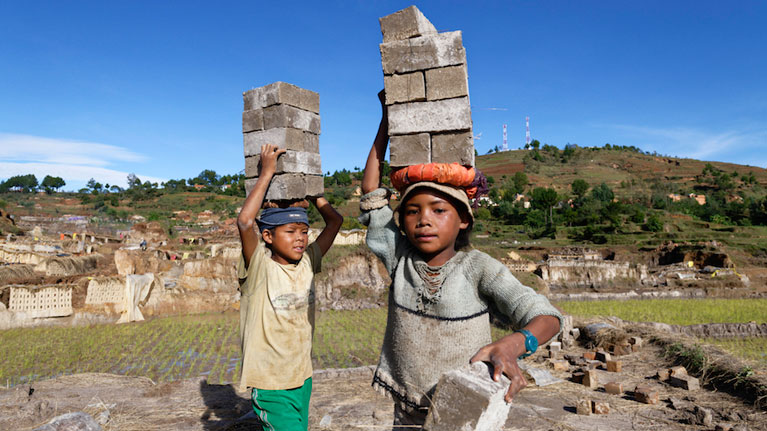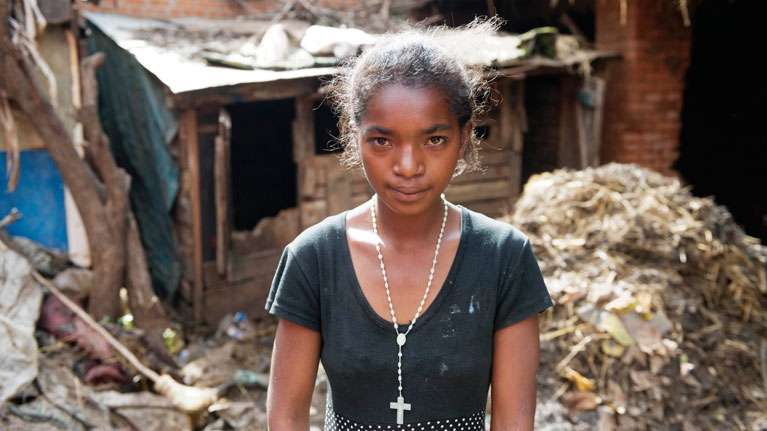Our impact, their voices
Poverty leads children from Madagascar to work in dangerous conditions
World Day Against Child Labour focuses this year on hazardous child labour and safe work for youth of legal working age. Almost half of the 152 million victims of child labour – 73 million – toil in hazardous work. In Madagascar, children in child labour in brickmaking and in domestic work, are among those who need to be protected.
ANTSIRABE, Madagascar (ILO News) – The brickyard didn’t seem to be worth a second glance, except perhaps for the breathtaking location. It was on the outskirts of Antsirabe, a town of about 200,000 people in Hautes Terres, 170 km south of the Malagasy capital. It’s just off the N7, a main road linking the south of the island to Madagascar’s capital. On our way back to Antananarivo, we noticed some tiny figures carrying bricks on their heads. As we drew closer, we realized they were children.
We met a 10-year-old girl called Sylvie. With her mother and older sister, she works five days a week from 6 a.m. to 5 p.m., carrying on her head an average load of eight bricks over hundreds of metres to the main road. We weighed one of the bricks. It was 2.6 kg. In other words, Sylvie’s neck was bearing a weight of more than 20 kg. Her mother explained that children transport 200 bricks a day. Adults carry 500. They are paid 9 ariary ($0.0028) per brick – which amounts to about 50 US cents per day.
The mother pointed to her two other young children perched on a rock under the sun in the middle of the brickyard. She is not happy about the situation but the family is so poor she has no choice. Officially, her children go to school – but the fact is, we were talking with them on a weekday during school hours.
We expected a foreman to kick us out at any moment. But no one showed up, as though the situation was normal for everyone. We even met other children as young as 6 years old, in public view, doing the same harmful, hazardous work.
“Sometimes, it hurts”

She also added a few more words that said it all: “You know, I’d rather go to school.”
Just a few kilometers from the brickyard, we met Nivo. She is 16. She was very young when she left her poverty-stricken family to work as a domestic worker in Antsirabe.
From dawn till dusk, Nivo does all the housework, (dishes, laundry, cooking, cleaning), and looks after the livestock without any kind of protection. She earns a paltry 40,000 ariary ($12) per month but she keeps only 5,000 ($1.50) and sends the rest her family. She has not seen them since she arrived in Antsirabe. She told us that she has never been to school.
When we asked about her future, Nivo seemed sceptical. “Who knows what will happen to me. There are no opportunities for me because I can’t read or write,” she explains sadly. She says she is treated well, but it would be hard for her to say anything else with her employers standing just a few metres away, listening to our conversation.
It is to prevent situations like Nivo’s, that the ILO set up a programme in Antsirabe to allow child domestic workers to change status and have access to vocational training. Lalaina Razanapera, head of the “Sarobidy” NGO, (which means “precious” in Malagasy), is in charge of implementing the project. She says it has provided vocational training to 190 children, sensitized 2,000 others and removed 2,500 from child labour.

Bonded labour
“There are many reasons for this,” says Dera Randrianarivony, labour inspector in charge of child labour, citing poverty and local customs which often oblige families in the region to hold costly traditional ceremonies they can’t always afford, prompting them to send their children to work for others. “It often becomes a form of bonded labour,” he adds.Randrianarivony seems to be armed with little more than goodwill – with almost no resources for his work. He has no vehicle and relies on the police to get around – who demand that he pays for the petrol. In the case of domestic work, he also faces legal obstacles. For example, he does not have the status of an investigating police officer so he is not authorized to enter private homes.
Limited means of action
We follow him on a search of a gargote – a small fast-food shop located near the train station, where he has been told that a child is working. On his arrival the child flees to the back of the shop in a panic, crying. Her name is Simone. She is 12 years old. Her story is all too common in the region. Her parents live in the country and are so poor that they sent her to work for her sister-in-law in town.Simone swears that she goes to school and is just “helping out” in the shop. But her story is belied by the fact that she doesn’t answer when asked for the name of her teacher and that her feet are far too dirty for a schoolchild.
There is not much the inspector can do except remind the shopkeeper of the law, stress that the shop is not a safe environment for a child to work, and threaten him with a fine.
“I went through hell”

Through an occupational training programme, supported by the ILO, she managed to escape from this situation. She learned basic animal husbandry and farming techniques, and now rents a small plot of land where she grows potatoes, carrots, garlic, leeks, cabbage, corn and beans. She is also raising a piglet she was given by the project at the end of her training. Her family is very proud of her.
Protection from hazardous work
For Lauréat Rasolofoniainarison, national project administrator at the ILO office in Antananarivo, it is crucial to talk to the child’s family.“Parents often tell us that they send their children to work instead of to school because they’re poor. But their families will probably stay poor unless we help them escape the vicious circle that leads them to send their children to work instead of to school. Their poverty is perpetuating a cycle that leaves no space for education or for improving skills and income. That is why decent work for adults and social protection floors are key weapons against child labour.”
Beate Andrees, Chief of the ILO’s Fundamentals Principles and Rights at Work Branch in Geneva conveys a similar message, highlighting the global need to end child labour and protect the safety and health of young workers of legal working age.
“It is critical to remove children below the minimum age for work from all forms of child labour, not least from hazardous work. We also need to ensure they have access to quality education and attend school at least until they complete compulsory education and reach the minimum legal age for work,” she concluded.